Outbreak 101
Students role-play a federal response to a pandemic.
In the early hours of April 6, 80 students awaited news of the latest death toll. That morning, they’d been tasked with controlling the spread of Clade X, an airborne parainfluenza virus with unknown origins and pandemic potential. Within hours, what had begun as two small outbreaks in Germany and Venezuela grew into a global disaster.
This context set the scene for a daylong tabletop modeling exercise designed to illustrate how emergency preparedness, foreign diplomacy and outbreak dynamics play out in real time.
“Imagine if a virus like Ebola, where we didn’t have a vaccine, [was] transmitted through the air. The situation could become seriously bad very quickly,” says Olivia Kezirian, an Epidemiology master’s student and lead organizer of the event.
The simulation, which was created by researchers at the Center for Health Security, assigned students the roles of National Security Council members and health officials with expertise in infectious diseases.
As the day progressed, students were briefed through memos and news broadcasts, then tasked with making executive decisions on emergency evacuations, travel bans, military mobilization, vaccine deployment and quarantines of confirmed and suspected cases.
“Every aspect of this scenario was drawn from real-life events—Ebola, SARS, MERS, H5N1,” says Eric Toner, MD, a senior scholar at the Center for Health Security. “This might have been a game with rules, but these were realistic dilemmas with real consequences.”
Despite careful considerations and calculations by the participants, the damage was done. By day’s end, representing 20 months since the start of the outbreak, there were 150 million simulated Clade X–related deaths around the world and still no vaccine.
“Pandemics happen,” says Toner. “We need to be ready.”
